The connection between creativity and psychopathology is belatedly highlighted in the specialized literature, but the interest for this subject has increased over the last few years. This study will analyze particularly artists from Romania, who come from a different social, historical, cultural and economic context. They are often marginalized, perceived as “strange” or stigmatized. This is due to their way of being more nonconformist, more relaxed or of their original outfit.
Objective. We wish to assess those facets of the personality dimensions that motivate and maintain artistic talent, which can influence the chances of success, highlighting those dimensions that facilitate the professional options developed, according to personal talent and skills.
Materials and method. We have included in our study a batch of 24 artists from various fields of activity, who filled out the Personality Inventory for Diagnostic and Statistical Classification Manual of Mental Disorders 5th Edition (PID-5) form, and the Openness, Extraversion, Conscientiousness, Agreeableness, Emotional Stability (DECAS) form.
Results. The correlations between increased openness, eccentricity and grandiosity can be advantageous factors in the artist profession. The increased values of conscientiousness can lead to the development of certain obsessive-compulsive type personality traits that can be beneficial under certain circumstances and can lead to perfectionism and perseveration. The unusual beliefs, suspiciousness and perceptual dysregulation are disadvantageous traits that can be the starting point for psychotic pathological manifestations.
Conclusions. There are dimensions that predispose to an increased aesthetic sense, creativity and fantasy, which can be important factors in choosing one’s profession, but can also create a vulnerability to forays into psychopathology.
Vulnerabilitatea personologică la artişti. Evaluarea trăsăturilor de personalitate prin scalele DECAS şi PID-5
Personological vulnerability in the artistic profession The assessment of personality traits through DECAS and PID-5 scales
First published: 16 aprilie 2021
Editorial Group: MEDICHUB MEDIA
DOI: 10.26416/Psih.64.1.2021.4760
Abstract
Rezumat
Legătura între creativitate şi psihopatologie este pusă tardiv în evidenţă în literatura de specialitate, însă interesul pentru această temă a crescut în ultimii ani. Acest studiu analizează în mod specific artişti din România, care provin dintr-un context social, istoric, cultural şi economic diferit. Adeseori ei sunt marginalizaţi, priviţi ca fiind „ciudaţi” sau stigmatizaţi, din cauza felului lor de a fi mai nonconformişti, mai destinşi şi a ţinutei originale.
Obiectiv. Dorim să evaluăm acele faţete ale dimensiunilor personalităţii care motivează şi întreţin talentul artistic, care pot influenţa şansele de succes, cu punerea în evidenţă a acelor dimensiuni care facilitează opţiunile profesionale elaborate, conform talentului şi aptitudinilor personale.
Materiale şi metodă. Am inclus în studiul nostru un lot de 24 de artişti din diverse arii de activitate, care au completat Inventarul de personalitate pentru Manualul de diagnostic şi clasificare statistică a tulburărilor mintale ediţia a 5-a (PID-5) şi Chestionarul Deschidere, Extroversiune, Conştiinciozitate, Agreabilitate, Stabilitate emoţională (DECAS).
Rezultate. Corelaţiile între deschiderea crescută, excentricitate şi grandiozitate pot fi factori favorizanţi în profesia artistică. Valorile crescute ale conştiinciozităţii pot duce la dezvoltarea unor trăsături de personalitate de tip obsesiv-compulsiv care pot fi avantajoase în anumite condiţii şi pot conduce la perfecţionism şi perseverenţă. Credinţele bizare, suspiciozitatea şi dereglarea perceptuală sunt trăsături defavorizante care pot fi punctul de plecare al unor manifestări psihopatologice de tip psihotic.
Concluzii. Există dimensiuni care predispun spre un simţ crescut estetic, spre creativitate şi fantezie, care pot fi factori importanţi în opţiunea profesională, dar care pot crea o vulnerabilitate spre incursiuni în psihopatologie.
Introduction
Art is a unique way of expressing the self, one’s own thoughts, ideas, feelings, emotions, in close connection with certain social, economic, historical, political and personal contexts.
Art may be defined and seen as a reflection of the creative side of the individual that essentially renders a personal, subjective affective experience. Art is one of the dimensions that define the human, next to the affective, cognitive and volitional component(1).
The preoccupation and interest for creativity, after 1950, is motivated by the importance that this dimension has on the elements of social, economic and cultural nature, an interest that is demonstrated by the large number of publications on this subject, particularly in the international literature, especially in recent years(2).
The interferences between mental disorders and creativity were first described in literature in the 1970s by Nancy Andreasen, at the University of Iowa, on a batch of 30 writers(3).
The first researches indicated a connection between creativity and psychopathology, creative functioning and unusual thinking, affective symptoms, personality traits and facets, and behavioural characteristics(4).
The studies performed and the publications on this subject involve dimensions such as neuroticism, openness, agreeableness and extraversion, which are increased in the groups of artists. Substance use is often encountered, to stimulate creativity(5).
Objective of the study
The main objective of the study: we set out to assess those facets of the personality dimensions that motivate and maintain the artistic talent, and always influence the chances of success, and the way it is still used in the practice of the profession.
Expectations: highlighting the dimensions involved in the various psychopathological decompensations of the assessed personality, the way in which they influence the dynamics of professional roles.
Materials and method
We included in our study a batch (N=24) from different professional artistic fields: actors, dancers, musicians, painters, writers, theatre critics, street artists, with different age, gender and background, and who filled out the PID-5 and DECAS forms, in the period 2018-2019. The batch was divided into three groups: actors, musicians and visual artists.
The collected data have been obtained prospectively. The statistical program used was PSPP. The test for determining the distribution of parameters was conducted using the Kolmogorov-Smirnov formula.
The Personality Inventory for DSM-5 (PID 5)
The Personality Inventory for DSM-5 is a 220-item self-rated personality traits assessment scale. PID-5 is a dimensional questionnaire based on the alternative model DSM‑5, a brief form of the Five-Factor Model in which there are stressed the maladaptive traits. It assesses 25 personality trait facets, including: anhedonia, anxiousness, attention seeking, callousness, deceitfulness, depressivity, distractibility, eccentricity, emotional lability, grandiosity, hostility, impulsivity, intimacy avoidance, irresponsibility, manipulativeness, perceptual dysregulation, perseveration, restricted affectivity, rigid perfectionism, risk taking, separation insecurity, submissiveness, suspiciousness, unusual beliefs and experiences, and withdrawal. The 25 specific facets (groups of 3-9) can be combined to yield indices of the five broader trait domains: negative affectivity (emotional lability, anxiousness, separation insecurity), detachment (withdrawal, anhedonia, intimacy avoidance), antagonism (manipulativeness, deceitfulness, grandiosity), disinhibition (irresponsibility, impulsivity, distractibility), psychoticism (unusual beliefs and experiences, eccentricity, perceptual dysregulation)(7).
DECAS – Openness, Extraversion, Conscientiousness, Agreeableness, Emotional Stability
This is a personality trait assessment instrument based on the Big Five Factor Model, created by Professor Florin Alin Sava (MD, PhD), comprising 97 questions, with “true/false” type answers. It is based on a dimensional model with five dimensions: openness, extraversion, conscientiousness, agreeableness and emotional stability, each domain having six facets, described by Costa and McCrae in 1985.
It is a questionnaire based on a dimensional model with five dimensions: openness, extraversion, conscientiousness, agreeableness, and emotional stability, each domain having five facets:
1. Extraversion: warmth, gregariousness, assertiveness, activity, excitement-seeking, positive emotions.
2. Agreeableness: trust, straightforwardness, altruism, compliance, modesty, tender-mindedness.
3. Neuroticism (as opposite to emotional stability): anxiety, anger-hostility, depression, self-consciousness, impulsiveness, vulnerability.
4.Conscientiousness: competence, order, dutifulness, achievement striving, self-discipline, deliberation.
5. Openness: fantasy, aesthetics, feelings, actions, ideas, values(8).
Results
The 24 persons who filled out the questionnaire had ages between 20 and 88 years old (18 males and 6 females). They all came from urban areas (Timişoara and Sibiu).
Figures 1, 2, 3, 4 and 5 show the correlation coefficient between the dimensions of the DECAS form and the facets of the PID-5 form.
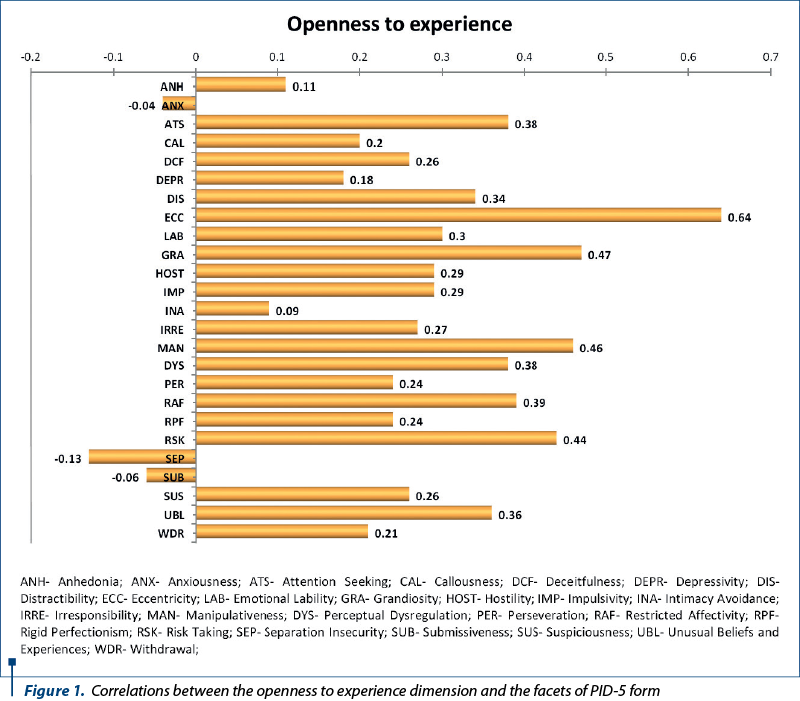

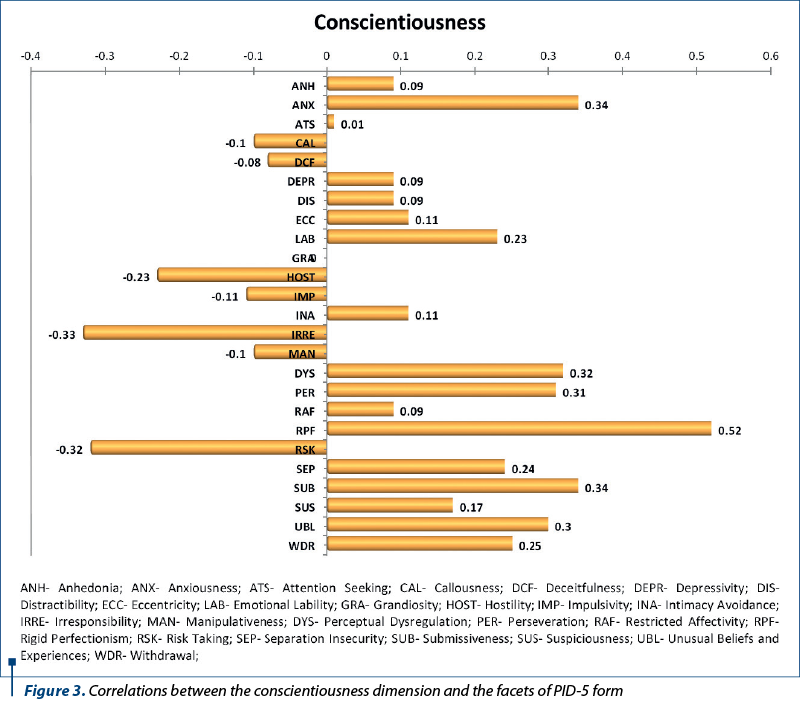
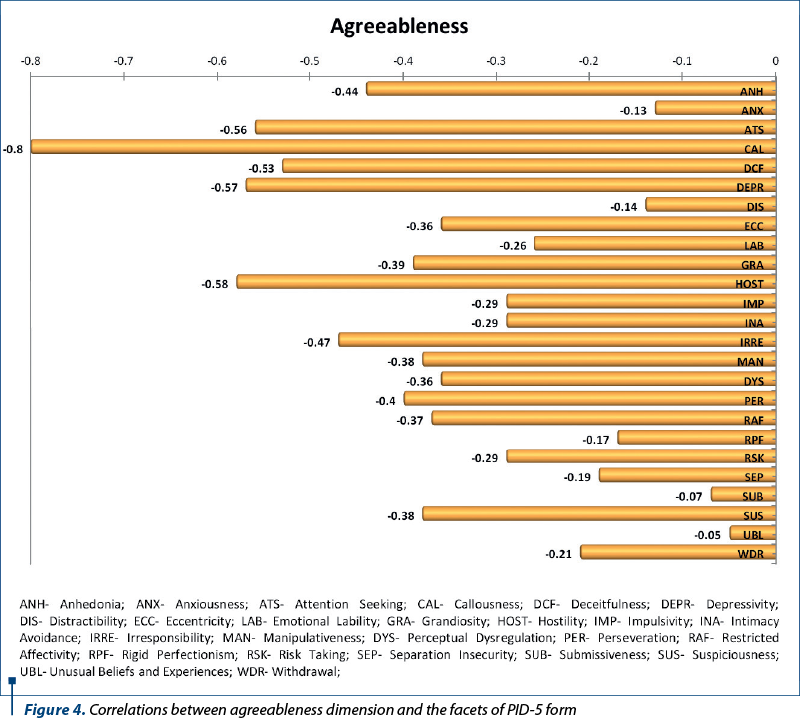
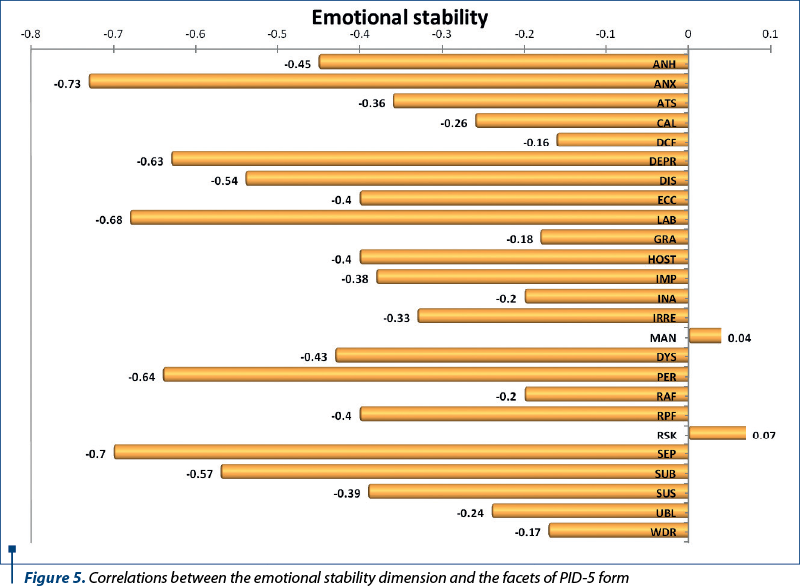
Discussion
We wish to highlight the advantageous and disadvantageous traits in the artist profession.
The correlations between increased openness, eccentricity and grandiosity can be advantageous factors in the artistic profession, but manipulativeness and risk taking, depending on certain circumstances, can be both advantageous and disadvantageous.
Unusual beliefs and suspiciousness as traits present in individuals with increased openness can lead to psychopathological decompensations.
Increased extraversion, together with low values of withdrawal and trauma avoidance, as well as high values of attention seeking, can be advantageous factors in an artist’s destiny, but impulsivity does not favour the artistic career.
High values of conscientiousness may lead to the development of certain obsessive-compulsive type personality traits that can be advantageous under certain circumstances as support for perfectionism, perseveration, openness to details and nuances. Unusual beliefs, suspiciousness and perceptual dysregulations can be disadvantageous traits and a starting point for psychotic pathological manifestations.
Agreeableness and emotional stability described in the Big Five theory are domains related to normality, therefore any negative correlation between these domains and the pathological facets of PID-5 become protective and advantageous factors in the professional growth.
Openness, extraversion and conscientiousness are defining domains which, even though they have a great influence on the evolution and growth of the artists professions, they may lead to psychopathological decompensations: an exaggerated openness leads to antagonism, disinhibition and psychoticism, extraversion to disinhibition, and conscientiousness leads to negative affectivity and psychoticism.
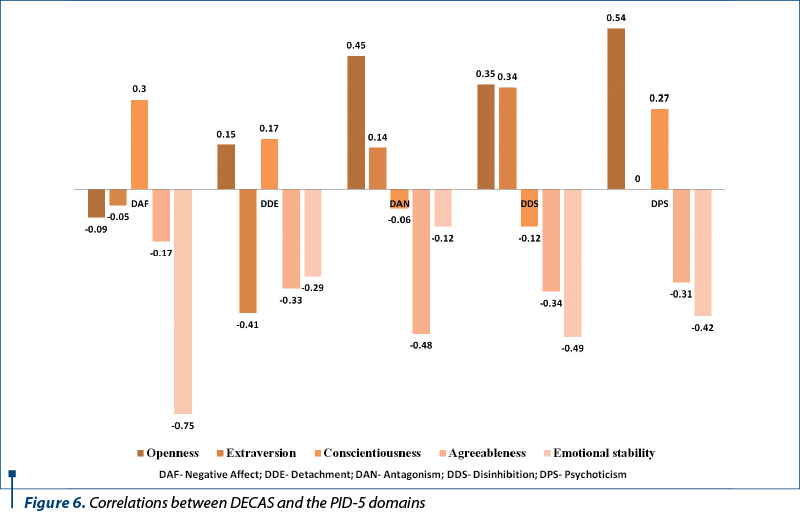
Conclusions
High values of openness predispose to an aesthetic sense, creativity and fantasy, that can be important factors in choosing one’s profession.
The correlations between extraversion and attention seeking represents an advantageous trait in the artist profession.
A moderate conscientiousness is a key factor in reaching the success, but very high values are associated with a vulnerability for psychopathological decompensations.
Agreeableness and emotional stability that include a mature defence mechanism lead to a durable professional stability.
The dimensional assessment of the personality traits attests to being a particular endeavour in acknowledging the personal abilities assigned to the professional role.
The interdimensional correlations developed by this study may also be used in shaping the professional abilities, as well as in the therapeutic exchange of personality disorders psychopathological decompensation.
Bibliografie
- Rusu M. Art and Conscious – philosophical and psychological dimensions of the artistic creation, Iaşi, Ars Longa Publishing. 2014, 5-6.
- Popescu G. The Psychology of Creativity – 3rd Edition, Bucharest, Fundaţia România de Mâine Publishing. 2007, 5.
- Andreasen NC. Creativity and Mental Illness: Prevalence Rates in Writers and their First Degree Relatives. American Journal of Psychiatry. 1987;144:1288–1292.
- Martindale C, Glover JA, Ronning RR, Reynolds CR. Personality, situation and creativity. Handbook of creativity. New York: Plenum; 1989, 211–321.
- Pavitra KS, Chandrasekar CR, Choudhury P Creativity and mental health: A profile of writers and musicians. Indian J Psychiatry. 2007 Jan-Mar;49(1):34–43.
- APA. DSM – Diagnostic and statistical manual of mental disorders – fifth edition. Washington DC: American Psychiatric Publishing, 2013.
- Sava F. DECAS Personality Inventory. User’s Manual, Timişoara. ArtPress, 2008.
Articole din ediţiile anterioare
O scurtă istorie a testelor de personalitate
Personalitatea este un subiect studiat încă din Antichitate, împreună cu tehnici de testare a acesteia. În ciuda acestui fapt, progresele în ceea c...
Dirk Braeckman şi cutia de conserve a lui Lacan
Dirk Braeckman* e un „pictor al nopţii”. Uitaţi că Dirk Braeckman e fotograf, uitaţi toate prejudecăţile pe care le-aţi putea avea despre fotografi...
Geniul şi sinuciderea (1)
Creaţia este o supremă împlinire a personalităţii, artistul fiind înzestrat cu capacităţi cognitive, intuitive şi emoţionale deosebite, căci el se ...
Narcisismul superior: Alexandru Macedonski
Recursul la DSM-5 pentru cele nouă criterii pe care le presupune tulburarea de personalitate narcisică, de asemenea recursul la diverse dicţionare ...